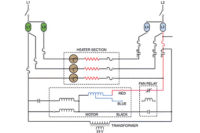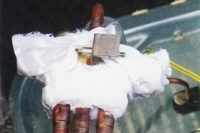Now, Bob’s company has promoted him to help train a new employee, right out of a school specializing in HVAC, just like Bob was. Bob is now Tim’s Btu Buddy. Tim is anxious to travel with Bob. Tim realizes that he is right out of school, with the theory and lab work that he accomplished in school, but still needs help. He knows that he worked with many of the components of the systems in the school, under ideal conditions with good light and air conditioning. Now it is into the field, sometimes under the house with poor lighting, or out on the rooftop in the sun, where the real action is. He is naturally and normally reluctant, but he has Bob to help guide him.
Bob and Tim have arrived at a home where the owner is complaining that the heat pump is not heating properly. It has been getting cold in the home during the late night and early morning hours. It’s really cold outside, about 10°F at night and 25° during the day.
When they arrived, the housewife met them at the door and let them in. She explained what was going on and led them to the thermostat. The thermometer on the thermostat read 60° and there was a blue light on at the thermostat. She then went on with her house work and Tim asked, “What is the blue light all about?”
Bob said, “The blue light is an indicator on this heat pump that the auxiliary heat is operating. These heat pumps are designed to heat the house down to about a 30° outdoor temperature with the heat pump. The heat pump is designed to remove heat from the outdoor air, and when the air gets colder, there is not enough heat in the air to heat the structure. As the outdoor temperature goes down, the structure needs more heat and when the temperature outside crosses the heat pump balance point, the heat pump needs the auxiliary heat. In this case, the auxiliary heat is electric strip heat.”
Tim then asked, “How does the auxiliary heat know when to come on?”
Bob said, “There are two basic methods of calling for strip heat. If the thermostat is set at 70° for the heat pump to come on, the thermostat will have a second stage set of contacts that will close and energize the auxiliary heat contactor at about 68° which will start up the strip heat (Figure 1). The strip heat was the last on and its contacts will open first as the temperature starts to rise. They will open at about 69°. This gives the customer the full benefit of the heat pump which is very efficient and keeps the strip heat off as much as possible.
“There is another variation to this where some of the heat strips are also controlled with an outdoor thermostat that is set at several balance points of the structure. For example, suppose it is determined that the heat pump can heat the structure down to about 32° and then the heat pump will run all of the time and not shut off and it will be able to keep the home at the thermostat set point. The first stage of electric heat is controlled with the second stage of the thermostat. When the outdoor temperature goes down to about 25°, the home temperature will begin to drop. The second stage thermostat will call for heat when the room temperature is about 68°. At about this time it will operate one stage of strip heat. The outdoor thermostat will close and allow the second stage of strip heat to energize (Figure 2). There may be three strip heaters or more. They may be staged to come on at even lower temperatures by means of another outdoor thermostat. There may be three outdoor thermostats to operate at different balance points.
“The way to keep this straight is to remember that there are two heating systems: the heat pump and the electric auxiliary heat. When the room thermostat second stage is energized, the blue light will come on and the auxiliary heat system is on. The heat pump is supposed to be running all of the time at this point. The system is not operating at peak efficiency any time the heat pump can carry the load by itself and the light is on, so the blue light is a notification or an alert that the second system is operating.
“The purpose of this is to save power consumption. For example, if the owner sets the thermostat to 60° to control the temperature at night, or when they are gone during the day and then set it back to 70° when they return, the heat pump and all stages of the strip heat will not come on at one time. The outdoor thermostats will not allow it.”
Tim asked, “How would you know which system you were working with?”
Bob said, “You would notice the outside thermostats and their bulbs that would usually be mounted close to the outdoor unit.”
Tim then asked, “What do we do next?”
Bob said, “Well, we know that both stages of heat are supposed to be calling for heat and they are not keeping the home warm. Let’s start with the strip heat. It is here in the closet with the air handler. Take the access door off of the strip heat.”
Tim removed the access door and Bob said, “Do you see the three strip heaters in all of those wires?”
Tim said, “There are so many wires that I don’t know what is what.”
Bob then explained, “Since the strip heat pulls the most current, the wires and terminals will be the largest. Knowing that, they will be easy to find. The fuses are a dead giveaway. There are three large fuses, one for each strip heat. Now get your ammeter and check for amperage flow in each circuit.”
Tim checked the circuits and said, “Only one heater is energized. Now what?”
Bob said, “I hate to shut the unit off, so let’s first explore the system with a voltmeter. Put one probe on the right side of the first heater and the other probe on the left side and see what you get.”
Tim placed the probes and said, “I get 232V.”
Bob then said, “Power is going to that heater. Now check the other two heaters.”
Tim checked them and said, “These both have line voltage of 232V.”
Bob said, “The heaters all have power, but only one is drawing current. What do you think?”
Tim said, “When a circuit has power and is not drawing current, the circuit must not be complete.”
Bob said, “Great point. We now have to examine the circuit. Shut off the power and let’s look at the heater.”
Tim shut off the power and Bob said, “Check the power connection with your voltmeter before you touch anything and be sure there is no power. You can’t be too careful.”
Tim checked the power by placing one lead on a ground surface of the cabinet and touching the other lead to the power supply, and the circuit was off, for sure.
Bob then said, “Take the power leads off of the middle heater that was not functioning and remove the heater.”
Tim removed the heater and said, “This heater has an open circuit. The wire is broken in two. It will require a new strip heater.”
Bob said, “Now take a light and look through the hole where you removed the heater and see if you can inspect the other two heaters. That was the reason for removing the middle heater.”
Tim looked at the two other heaters and said, “One heater is an open circuit and the other looks good.”
Bob said, “Put the old heater back in place and tape the wires up instead of connecting them. That way, we can keep the heat on and running while going after two heaters.”
Tim said, “Boy, that is a great idea to leave the heat on as long as we can.”
They then explained the situation to the housewife and went to get the new heaters.
As they were driving away, Tim asked, “Do you suppose that the heaters are all that is wrong with that system?”
Bob answered, “It seems that the heat pump running with one strip heat should do a better job of maintaining the house temperature. When we get back with the new strip heaters and get them operating, we will investigate the actual heat pump and check it out.”
(To be continued next month.)
Publication date: 01/23/2012












